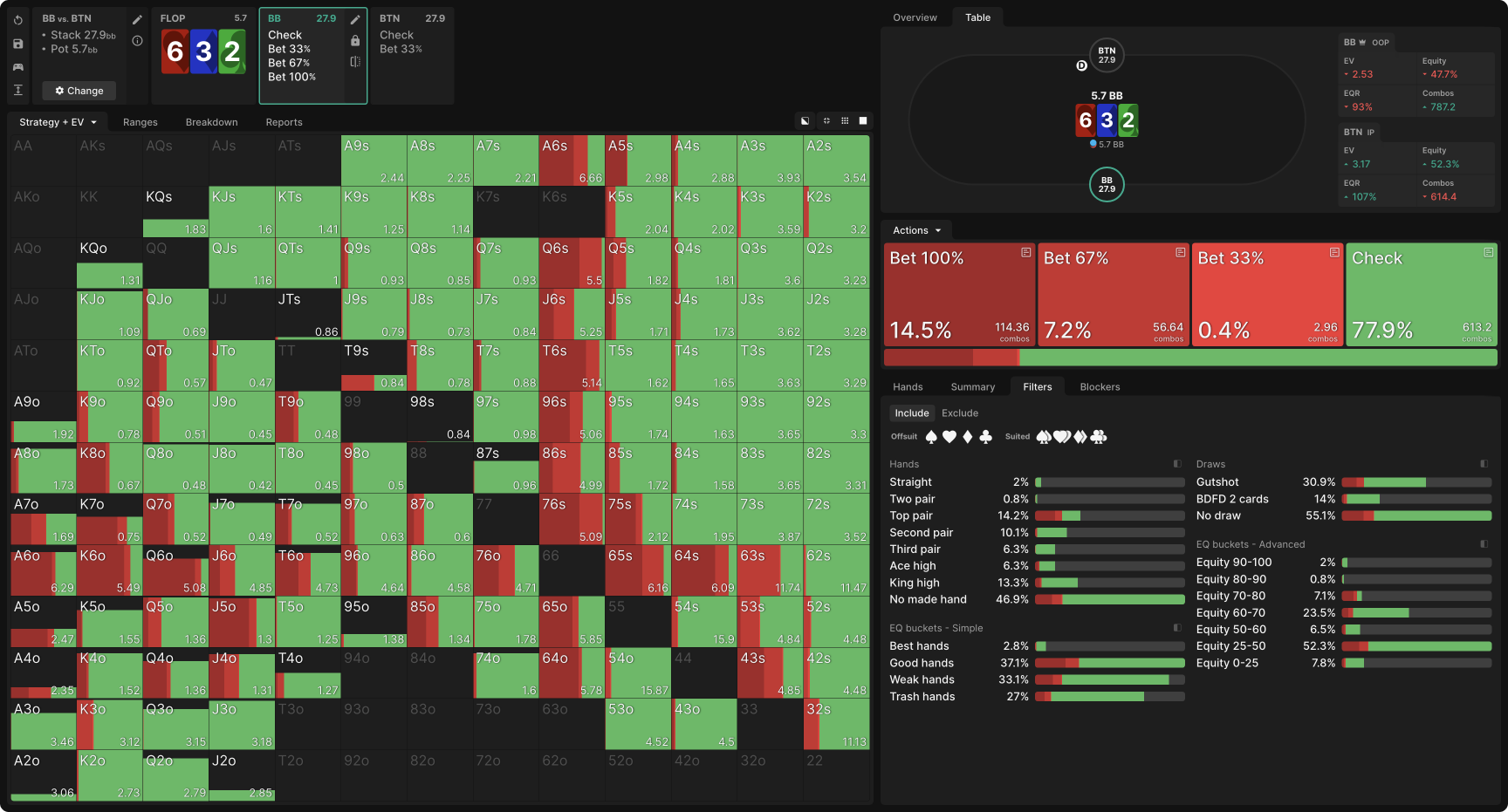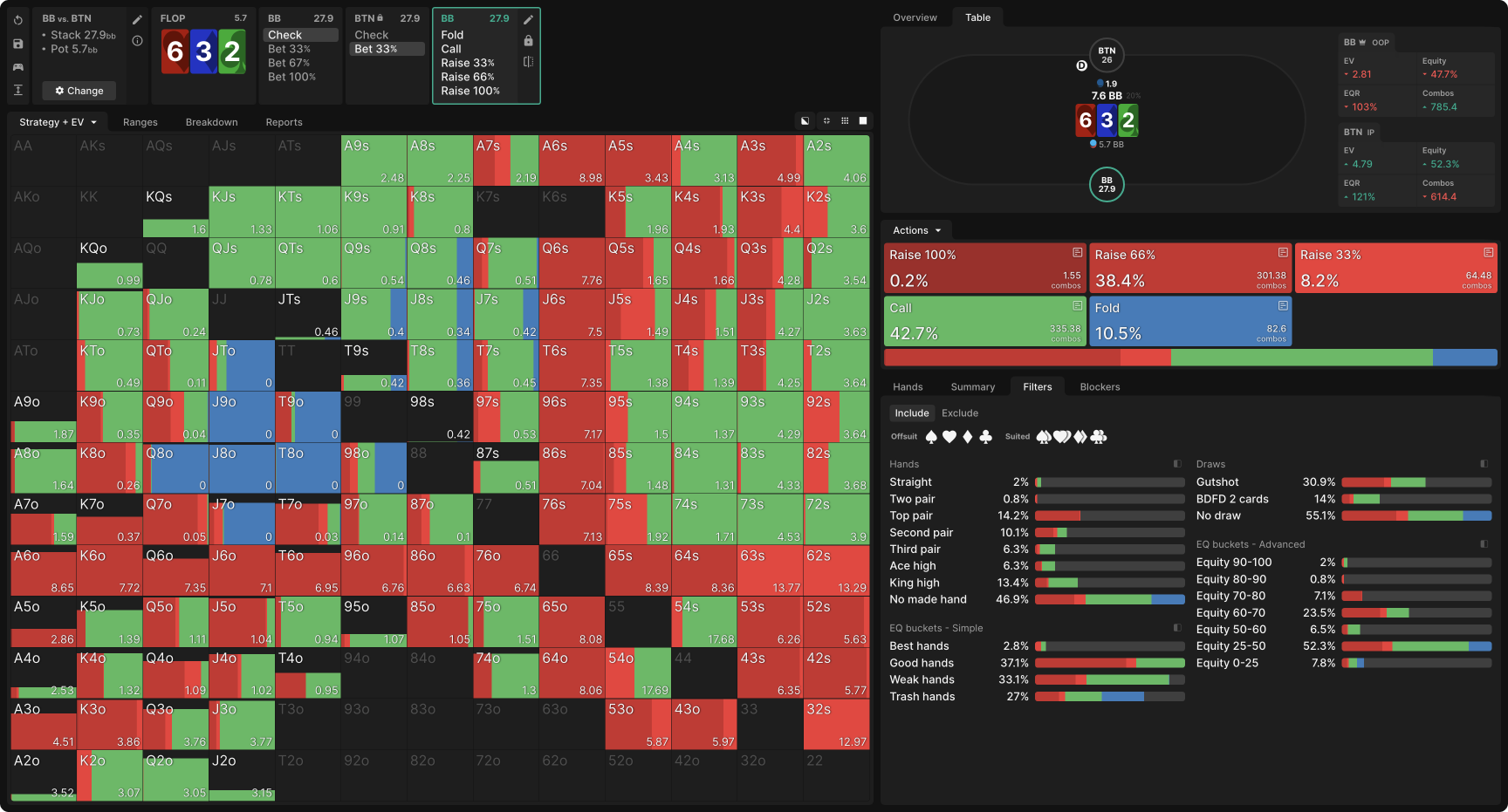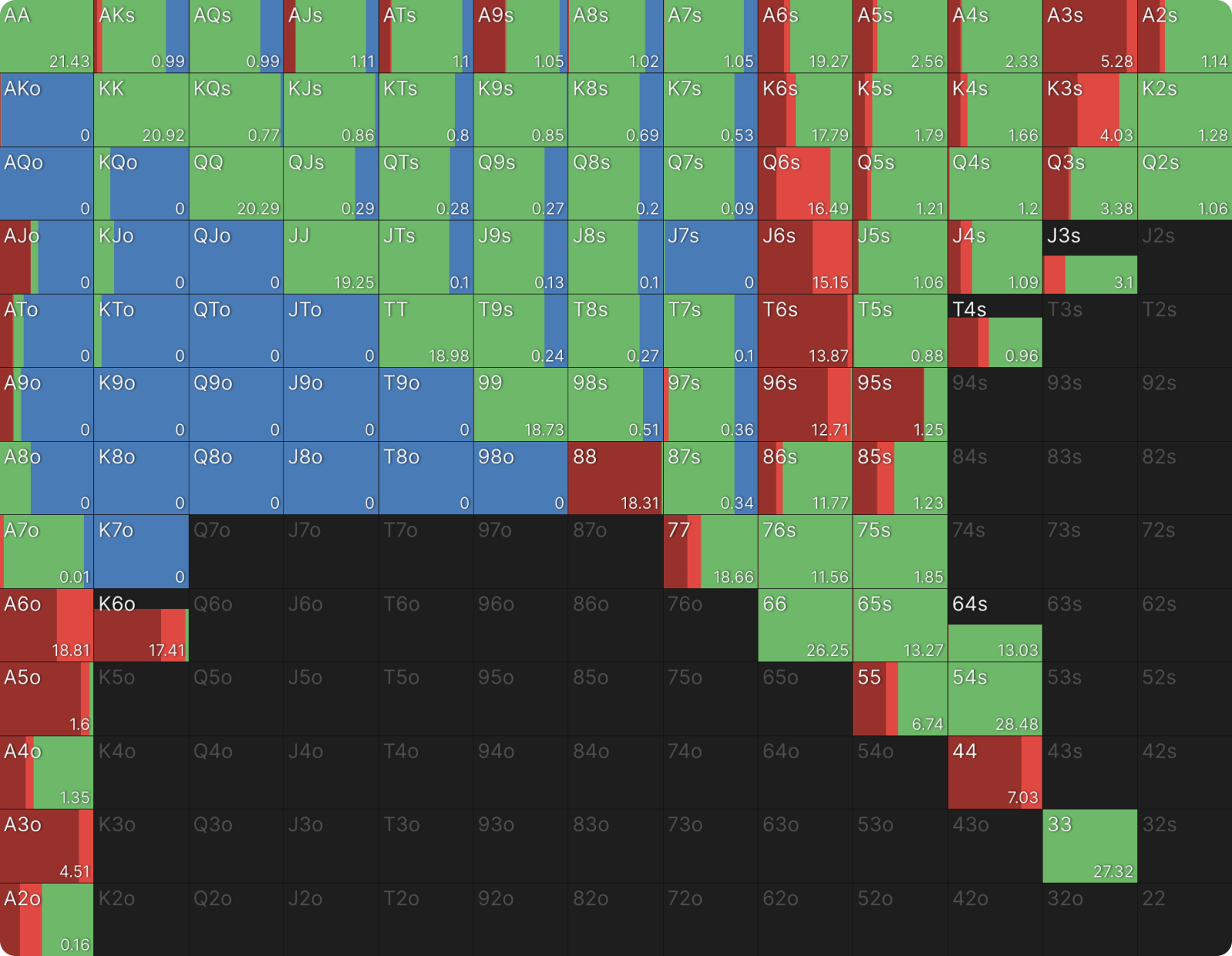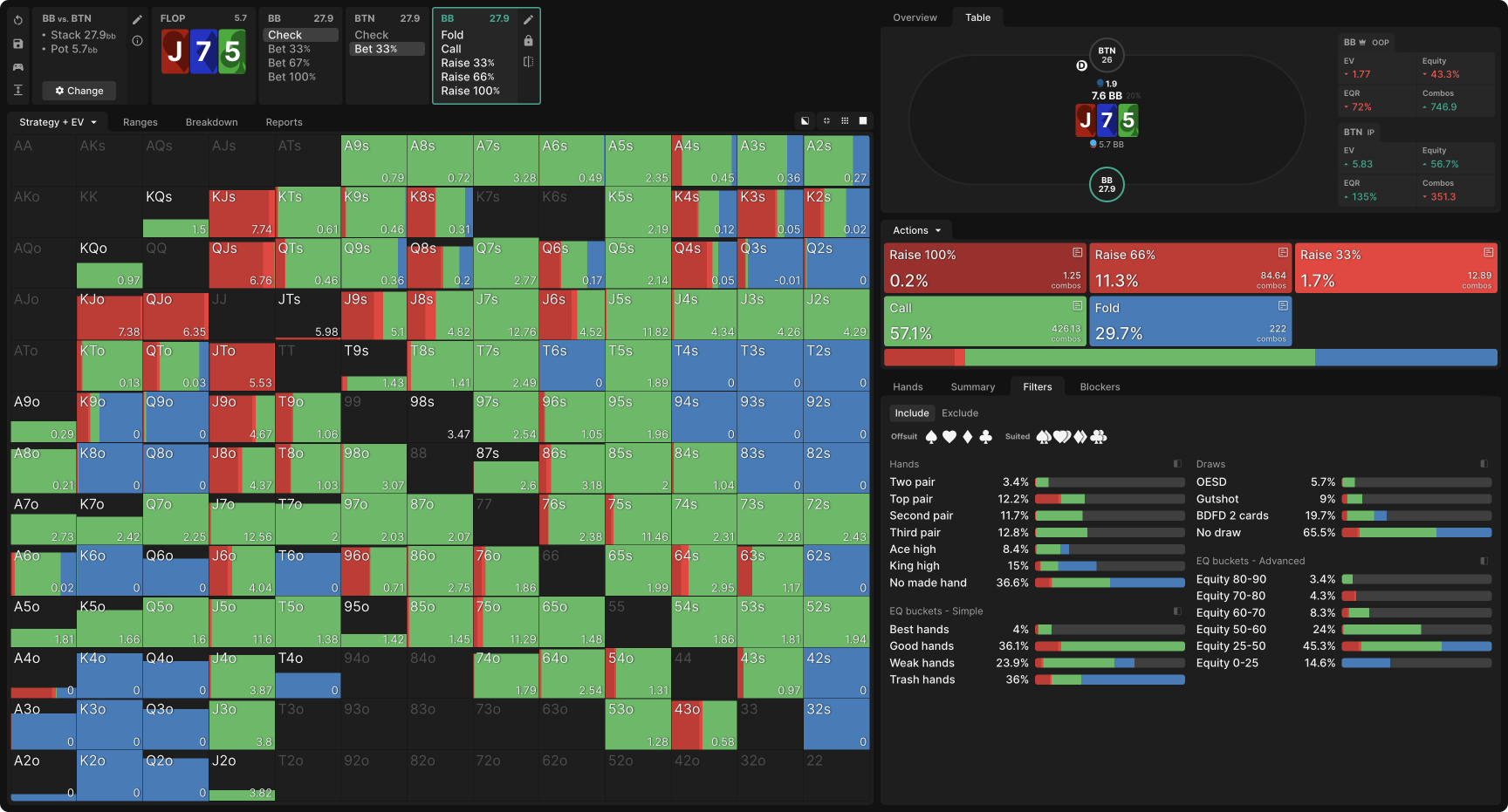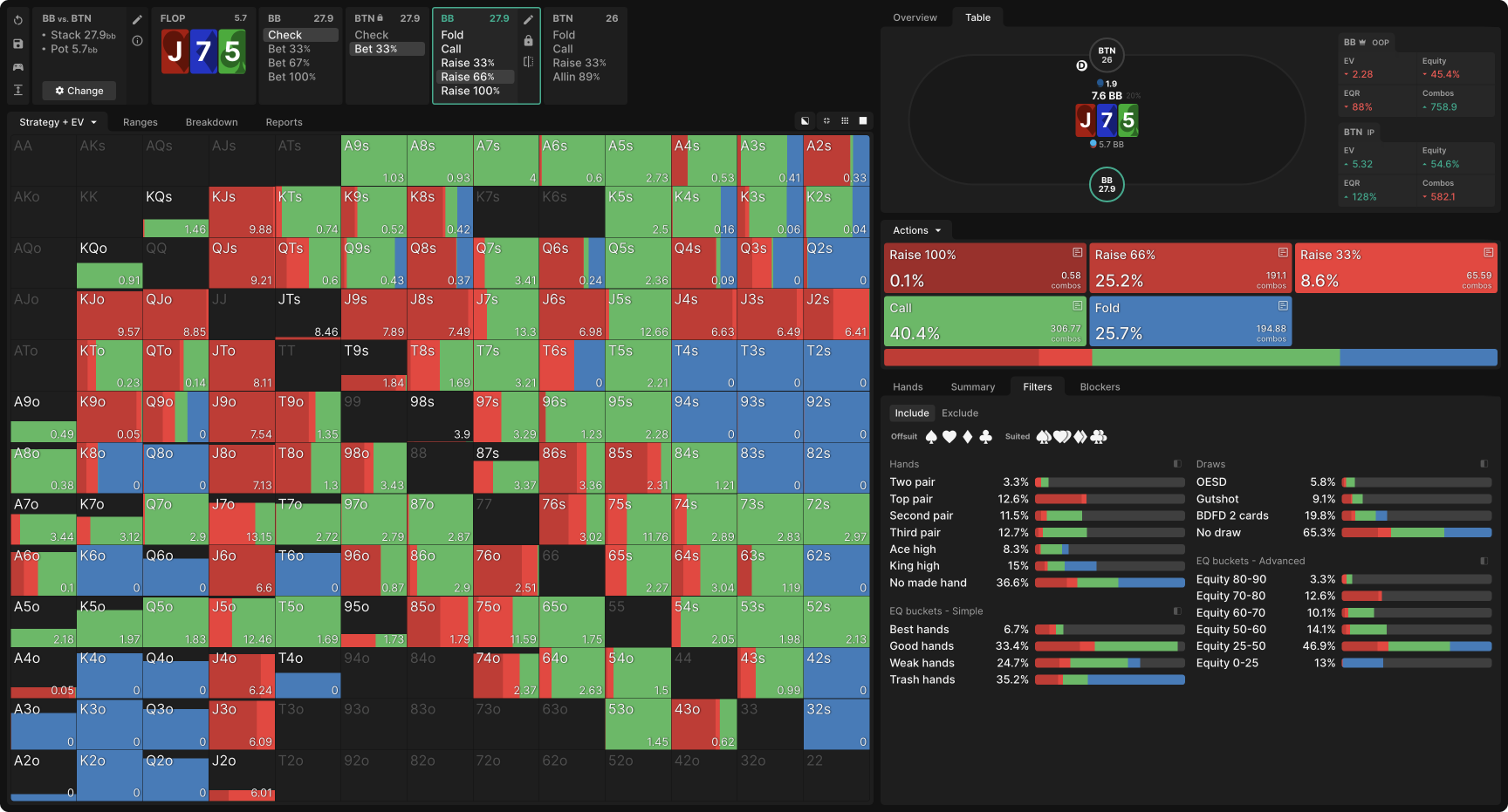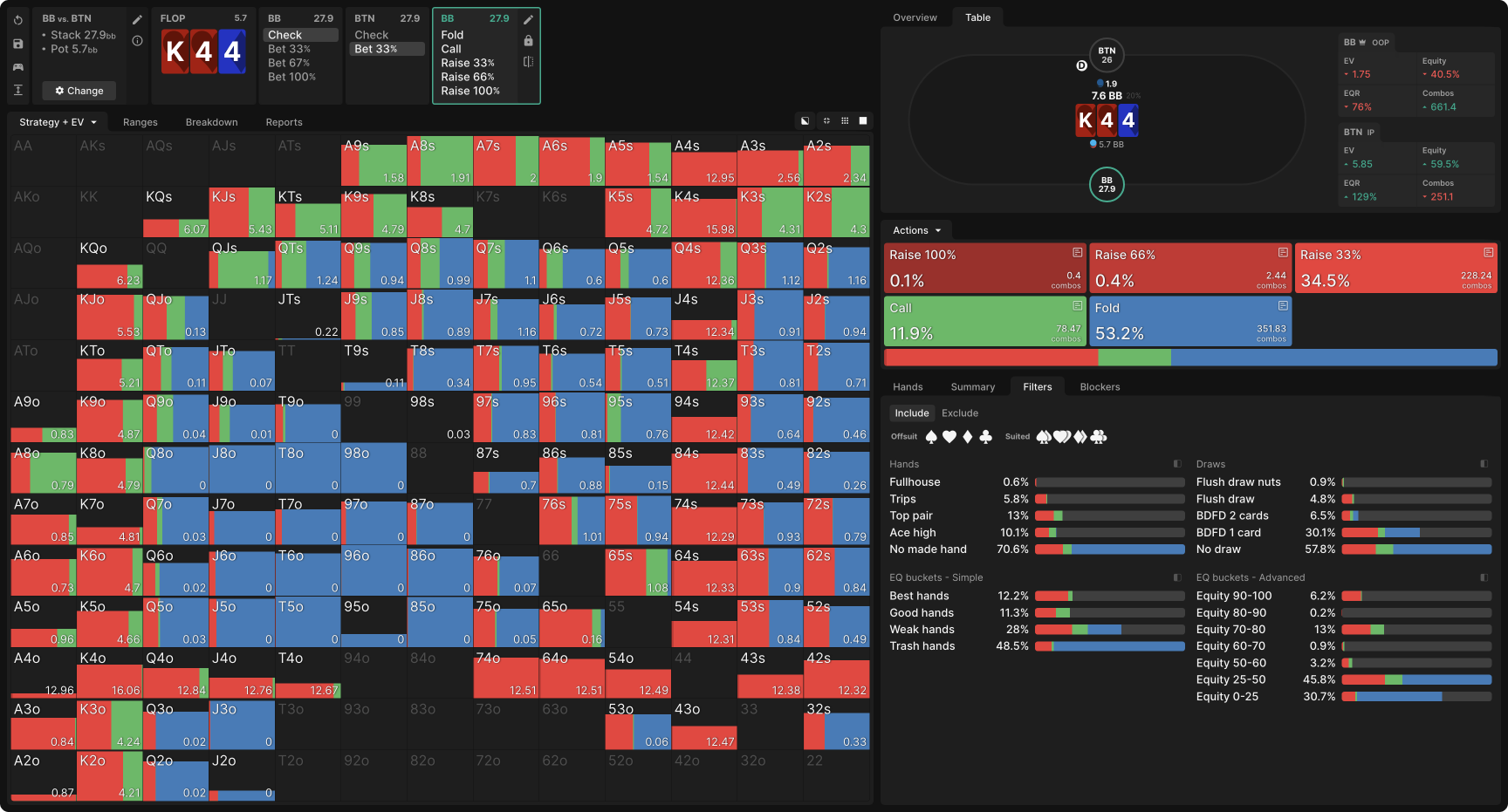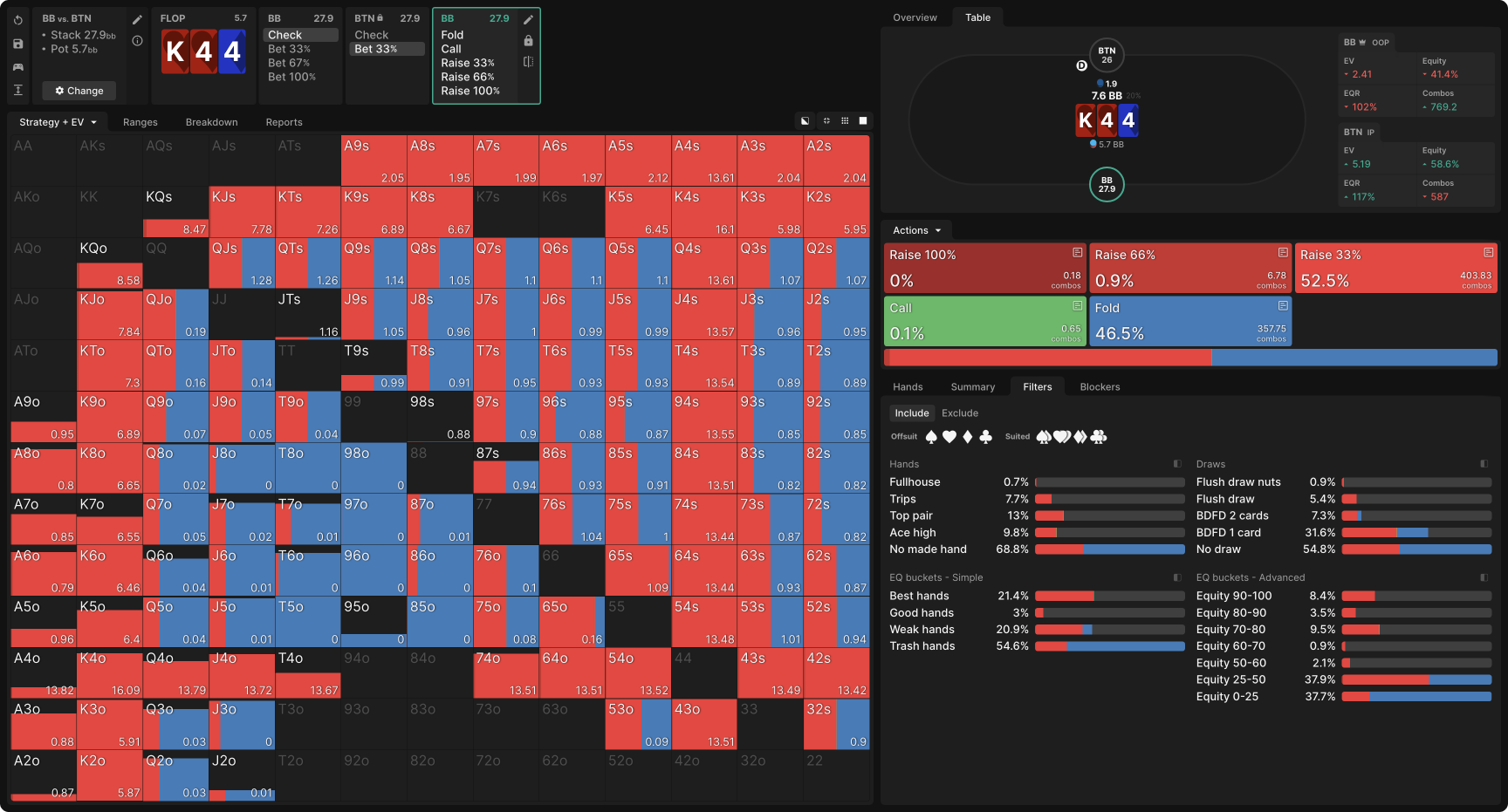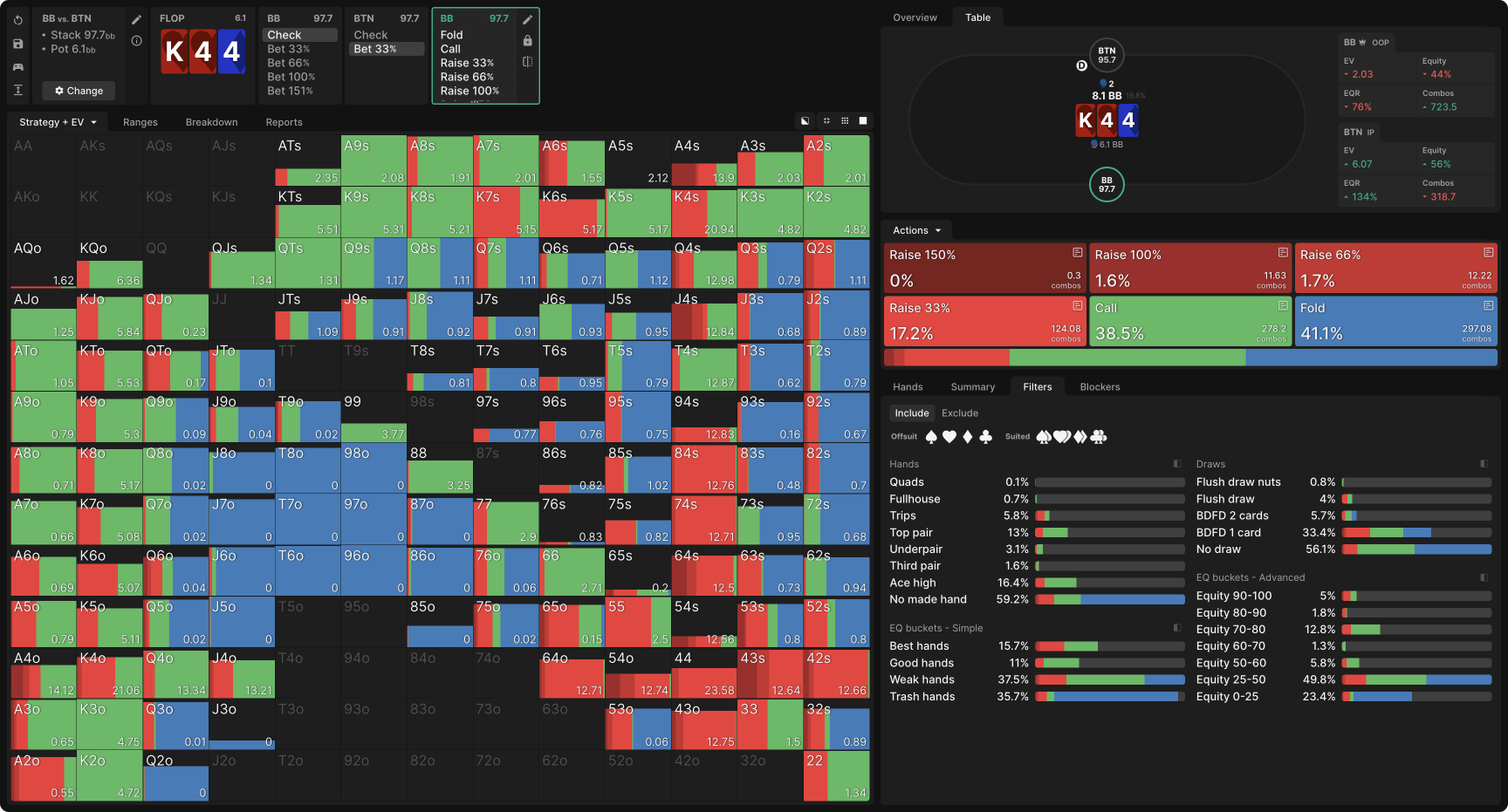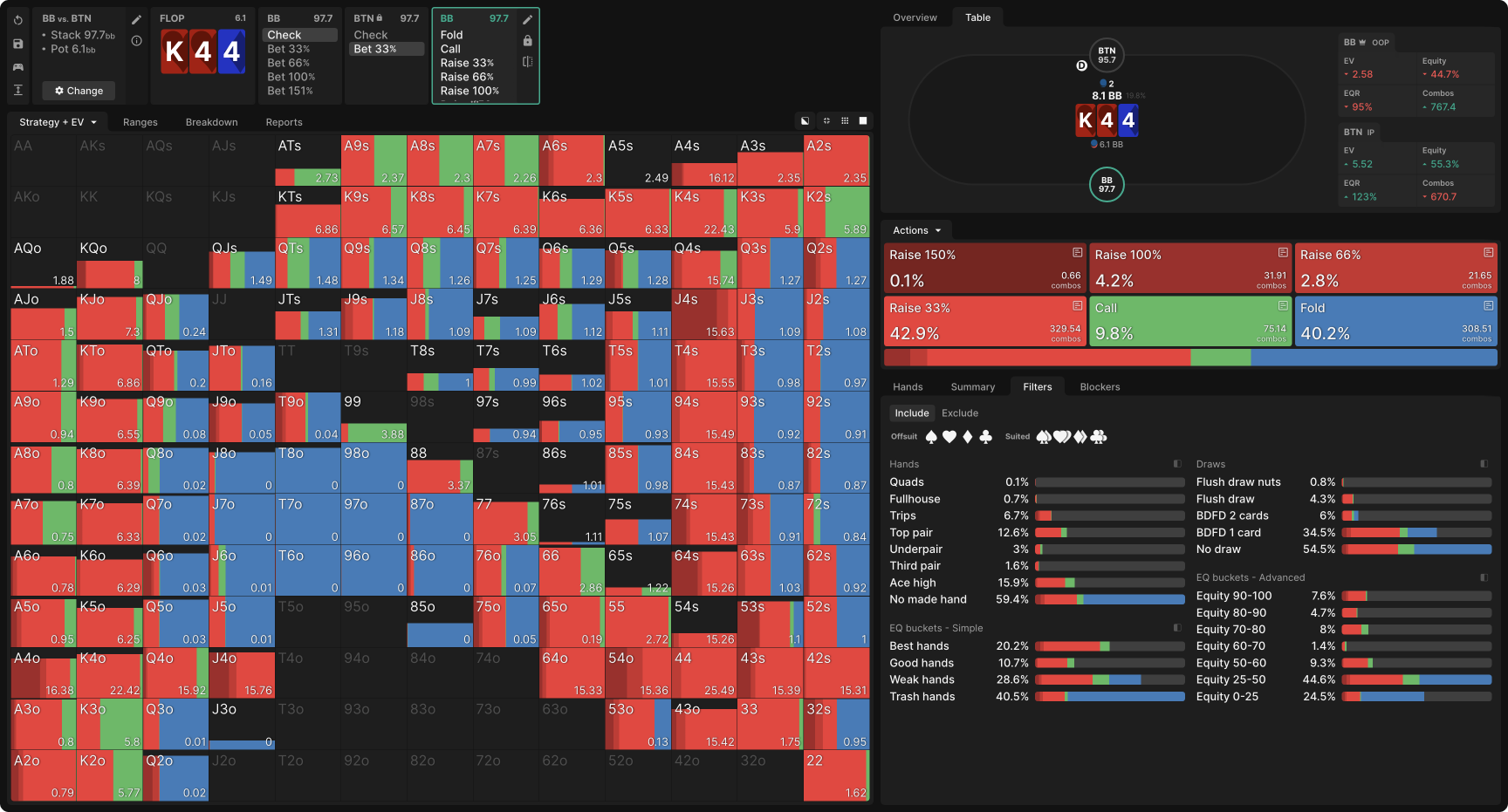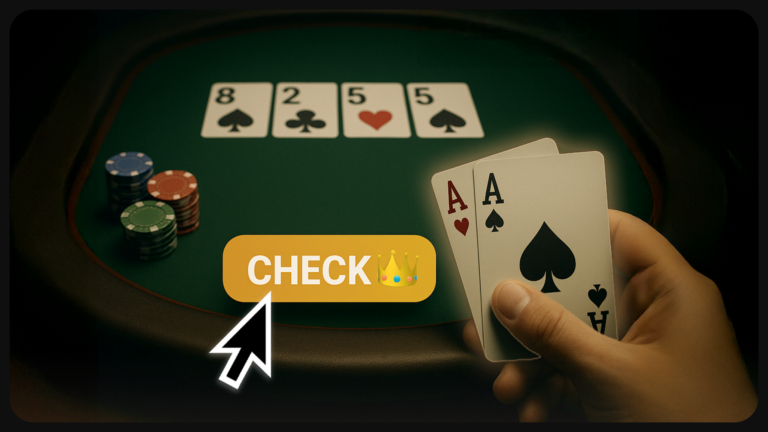Exploiting Excessive C-Betting by IP
On some flops, it is simply not possible for the preflop raiser to continuation bet too often. The unexploitable, solver-approved strategy is already to bet their entire range. In other cases, it is close enough that simplifying to betting their entire range does not open them up to significant exploitability (though it does make it all the more important for the blinds to respond with appropriate aggression).
However, the raiser is not supposed to bet even half their range on less favorable flops. If they bet too often in these spots, their opponent can exploit them in multiple ways, some more intuitive than others. In this article, we will conduct several experiments using the nodelocking feature to learn how to exploit over-aggressive continuation bettors.
The Experiment
These simulations are based on 30bb ChipEV preflop ranges in a single-raised pot between a BTN raiser and a BB caller. While the general principles of how to exploit an in position opponent who bets too often apply to other scenarios as well, these stack depths and positions bring the principles into a particularly clear focus.
The BB, acting first, may check or bet 33%, 66%, or 100% pot. The BTN’s only continuation bet size is 33%, and we will experiment with what happens when we nodelock them to bet their entire range. The BB may respond to this bet by calling, folding, or raising 33%, 66%, or 100% pot. If they raise, BTN has the same options. Options on later streets are determined using the Automatic feature.
The Low Connected Flop
At equilibrium, donk betting is an important part of BB’s strategy on 6♥3♦2♣. They have a lot of 6-x, which is strong enough to play a fairly big pot on the flop but will lose a lot of value on later streets, as the turn and river will almost certainly bring overcards.
BB’s Donk Betting Strategy
If BB checks, BTN bets 62.5% of their range, after which BB responds mostly by calling, raising just 11% of their range. So many of their best hands went into their donk betting range that they do not have enough value left to balance a wider check-raising range.
BB donk bets to prevent BTN from checking behind the flop. If BTN is never going to do that, then BB prefers checking to induce bets.
When we nodelock BTN to bet their entire range, BB has no incentive to donk bet. The main reason to bet a hand like J6 would be to prevent BTN from checking behind the flop. If BTN is never going to do that, then BB prefers checking to induce bets from the many weaker hands in BTN’s range. Then, they can raise all those top pair hands to get even more money into the pot and deny equity to BTN’s live overcards:
Notice that BB’s primary exploit is raising more, not calling more. Calls do not really “punish” BTN for betting too often because they will still get to realize the equity of their bluffs on the turn and perhaps the river as well.
Nor are these raises pure bluffs. Indeed, BB still has a folding range, suggesting that raising any two cards is not necessarily profitable. Rather, it’s a value-heavy raising range centered around top pair (BB raises literally all their top pair), second pair with a good kicker, and bottom pair with a gutshot. These hands are not bluffs, but they still benefit from fold equity because they are so vulnerable to getting outdrawn.
Raising top pair here is a bit like raising AK preflop: you probably have the best hand, but you’re still happy to get folds. You are so far ahead that the profitability of the raise does not depend upon your opponent’s response. If they fold often, you profit from denying equity to many hands with a 25% chance or so of drawing out on you. If they call often, they are putting in money from way behind. And if they raise often, your hand is strong enough to go to the felt.
The one thing they can’t do is consistently have a hand better than yours. Check-raising top pair capitalizes on a mistake they already made—betting the flop too often—not on a mistake you’re hoping they’ll make in response to the raise.
Raising top pair here is a bit like raising AK preflop: you probably have the best hand, but you’re still happy to get folds.
That said, after betting this often, it would be easy for BTN to make a mistake in response to a BB raise. Specifically, it would be easy for them to over-fold because the GTO response for them entails some awfully ambitious and counterintuitive calls and raises:
Is your typical opponent going to call a check-raise with K♠J♠? Are they going to shove AJo? If we introduce an additional nodelock to make BTN fold 50% of hands to this check-raise rather than 44%, then BB can profitably raise any two cards:
To summarize the exploits against an opponent who continuation bets too much:
- Stop donk betting.
- Check-raise more aggressively for thin value and protection.
- If they will over-fold to your raise, which is easy to do once they’ve made the mistake of betting so many weak hands, then you can also check-raise bluff more.
The Medium Coordinated Flop
J75r is another board where BTN’s equilibrium strategy involves a lot of checking, with about 40% of their range. Unlike on 632r, BB does not do any donk betting.
When facing a 33% pot continuation bet, BB check-raises at a moderate frequency, with an emphasis on top pair with a good kicker. Although top pair is less vulnerable to overcards on this board than on 632r, it is more vulnerable to straight-completing turns that may result in winning less, even if they do not cost them the pot. They fold the bottom 30% of their range.
When we nodelock BTN to range-bet, BB folds a bit less, but as on 632r, the major change is their raising frequency, which nearly triples.
They raise all their top pair, plus a lot more backdoor straight and flush draws. They still mostly slowplay two pair, which wants BTN to turn top pair.
As for those folds, they could easily become profitable bluff raises. GTO Wizard’s response to a 66% pot check-raise entails pure calling KQo and bottom pair. Against human opponents who are less likely to find those calls, you should raise rather than fold your worst hands.
High Card, Low Pair
This effect is most pronounced on K44tt, where BTN’s equilibrium continuation betting frequency is just 42.8%. Even so, BB responds with an aggressive strategy of small raises with more than a third of their range, including most of their trips and King-x.
When we nodelock the BTN to bet their entire range, we once again see no donk betting from BB (they donk bet about 13% at equilibrium). We also see no calling. Almost all of the increase in BB’s raising frequency comes from hands that called at equilibrium, not hands that folded:
Deeper Stacks
For this final experiment, we keep the same betting options but change the effective stacks to 100bb. Will this make calling more appealing on the K44tt board if the weaker top pairs are no longer strong enough to play for stacks? Will it make larger raises more appealing, as BB will want to force bigger pots with their trips? Let’s find out.
The unlocked solution with 100bb does not feature any larger raises, but it does include a small donk betting range of about 6% of hands, centered around 4-x:
BTN bets 47.4% of their range after BB checks, a slight increase from 42.8% in the 30bb scenario. BB still prefers the small size when they raise, but as predicted, top pair (King-x) does a lot more calling now that stacking off is not so appealing (due to the higher SPR). This supports a wide calling range that also includes some pocket pairs, high card hands, and backdoor hands:
Most of those calls drop out when we nodelock BTN to range-bet, as does the donk betting. BB still uses the small raise size almost exclusively, but most of their calls have become raises:
Hands like QT with a backdoor flush draw and A8o have too much equity to fold on this flop. Raising is tempting because they benefit from denying equity even when they’re ahead, but it’s risky because these hands perform very poorly against BTN’s best hands.
Once we expand BTN’s betting range, those best hands are a much smaller proportion of it. BTN’s equilibrium betting range already included most of their best hands, so those “extra” bets come almost entirely from weaker holdings. This shifts the incentive for hands like A8 and QT, which face little additional risk but stand to gain a much greater reward from raising into so many more weak hands.
Conclusion
The main takeaway from this article is to fight fire with fire! Raising is the essential exploit against overly aggressive opponents. This is especially true on early streets and when you are out of position. Calling instead of raising enables them to realize the value of both their hand and their position on later streets, mitigating the magnitude of their mistake.
Few hands you could hold are strong enough to take on that risk, and even when you do have such a hand, you are incentivized to raise so many other hands anyway that you should have no trouble getting action.
The best candidates for these “extra” raises are not your worst hands but rather the middle of your range, hands that might otherwise have called against a less aggressive opponent. Much like AK before the flop, these hands benefit from folds while still performing reasonably well against calls. Bluff raising could easily be profitable as well, but it requires your opponent to make the additional mistake of over-folding, which is easier to do after betting too many weak hands.
Finally, it is important to understand the theory behind why donk betting is a mistake if your opponent will continuation bet too often because it gets at a more general point about exploitation.
Few hands you could hold are strong enough to take on that risk, and even when you do have such a hand, you are incentivized to raise so many other hands anyway that you should have no trouble getting action.
The best candidates for these “extra” raises are not your worst hands but rather the middle of your range, hands that might otherwise have called against a less aggressive opponent. Much like AK before the flop, these hands benefit from folds while still performing reasonably well against calls. Bluff raising could easily be profitable as well, but it requires your opponent to make the additional mistake of over-folding, which is easier to do after betting too many weak hands.
Finally, it is important to understand the theory behind why donk betting is a mistake if your opponent will continuation bet too often because it gets at a more general point about exploitation.
If you expect your opponent will make a mistake at some future node in the game tree, you have extra incentive to adapt your play at earlier decision points to increase the likelihood your opponent will end up in the situation where they are likely to make the mistake you intend to exploit.
Author
Andrew Brokos
Andrew Brokos has been a professional poker player, coach, and author for over 15 years. He co-hosts the Thinking Poker Podcast and is the author of the Play Optimal Poker books, among others.

